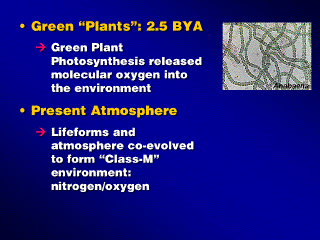The secondary
atmosphere existed for some time, except that as the Earth cooled and solidified,
the atmosphere cooled and could not contain as much water vapor as before. The
excess vapor condensed and formed the oceans. Since carbon dioxide is water
soluble, it slowly dissolved into the oceans to form carbon solids, and the
carbon dioxide content of the atmosphere was reduced to almost nothing. Life
was able to develop and evolve in the chemical-laden oceans (it could not survive
out of the water because of the lack of atmospheric oxygen compounds to absorb ultraviolet radiation from the sun).
 More recently, green plants evolved in the oceans (first as blue-green
algae). These organisms performed Green Plant Photosynthesis, which was
an important development because it released oxygen into the atmosphere (previously,
there was only the small amount from the breakdown of water vapor by ultraviolet radiation).
The accumulation of oxygen in the atmosphere (there were no organisms at the
time that could utilize the oxygen) led to the development of the stratospheric
ozone layer, which helped block the Sun's ultraviolet radiation from reaching the Earth's
surface. This then allowed life to evolve on dry ground, leading to our current
situtation.
More recently, green plants evolved in the oceans (first as blue-green
algae). These organisms performed Green Plant Photosynthesis, which was
an important development because it released oxygen into the atmosphere (previously,
there was only the small amount from the breakdown of water vapor by ultraviolet radiation).
The accumulation of oxygen in the atmosphere (there were no organisms at the
time that could utilize the oxygen) led to the development of the stratospheric
ozone layer, which helped block the Sun's ultraviolet radiation from reaching the Earth's
surface. This then allowed life to evolve on dry ground, leading to our current
situtation.
The appearance of aerobic
(oxygen-using) organisms soon after the green plants started photosynthesizing
did provide a sink for the oxygen, and at the same time provided a source of
carbon dioxide that the plants needed for photosynthesis. Thus, a mutualistic
steady-state cycle between the green plants and aerobes was set up and maintains
the current oxygen content. Meanwhile, nothing much happens to nitrogen gas
chemically, so its slow outgassing from the Earth and its release from certain
chemical processes involving surface rocks and plants (denitrification) led to the large accumulation
of nitrogen in the present atmosphere.



 More recently, green plants evolved in the oceans (first as blue-green
algae). These organisms performed Green Plant Photosynthesis, which was
an important development because it released oxygen into the atmosphere (previously,
there was only the small amount from the breakdown of water vapor by ultraviolet radiation).
The accumulation of oxygen in the atmosphere (there were no organisms at the
time that could utilize the oxygen) led to the development of the stratospheric
ozone layer, which helped block the Sun's ultraviolet radiation from reaching the Earth's
surface. This then allowed life to evolve on dry ground, leading to our current
situtation.
More recently, green plants evolved in the oceans (first as blue-green
algae). These organisms performed Green Plant Photosynthesis, which was
an important development because it released oxygen into the atmosphere (previously,
there was only the small amount from the breakdown of water vapor by ultraviolet radiation).
The accumulation of oxygen in the atmosphere (there were no organisms at the
time that could utilize the oxygen) led to the development of the stratospheric
ozone layer, which helped block the Sun's ultraviolet radiation from reaching the Earth's
surface. This then allowed life to evolve on dry ground, leading to our current
situtation.